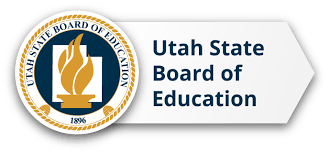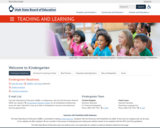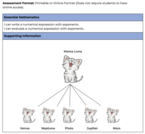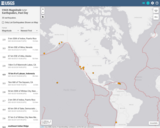
Keyboarding high frequency word passage that can be used for keyboarding assessment
- Subject:
- Career and Technical Education
- Material Type:
- Assessment
- Provider:
- Utah State Board of Education
- Date Added:
- 07/16/2024


Keyboarding high frequency word passage that can be used for keyboarding assessment

Keyboarding high frequency word passage that can be used for keyboarding assessment

Keyboarding high frequency word passage that can be used for keyboarding assessment

Learn about kindergarten readiness, activities for learning at home for those who are ready for kindergarten-level learning, and frequently asked questions about kindergarten.

Kittens Galore!: Standard 6.EE.1 Write and evaluate numerical expressions involving whole-number exponents.
This formative assessment exemplar was created by a team of Utah educators to be used as a resource in the classroom. It was reviewed for appropriateness by a Bias and Sensitivity/Special Education team and by state mathematics leaders. While no assessment is perfect, it is intended to be used as a formative tool that enables teachers to obtain evidence of student learning, identify assets and gaps in that learning, and adjust instruction for the two dimensions that are important for mathematical learning experiences (i.e., Standards for Mathematical Practice, Major Work of the Grade).

Book Love addresses student apathy head on, first by recognizing why students don't read assigned readings or for pleasure. The book provides advice for helping students find books that are right for them, building in time to read, reflect, and share. The website provides workshop handouts, reading lists, videos, etc. In the article, “Let them read, please” Penny describes what it takes to build a culture of reading in secondary schools.

The Knoster Model was created by Tim P. Knoster, Ed.D., professor at the McDowell Institute for Teacher Excellence in Positive Behavior Support in the College of Education at Bloomsburg University of Pennsylvania. The model is the result of years of rigorous behavioral science research and testing. The Knoster Model defines six elements that must be addressed to affect desired change. This model can be used as a resource and guide for applying theories of change at a systemic level.

In this Cult of Pedagogy podcast, Jennifer Gonzalez defines three different approaches to designing rubrics to assess student work and provides examples of each, while discussing the benefits and drawbacks of the different models. Teachers may find these resources useful as they consider how they use their rubrics for response to and/or assessment of student writing.

This microcredential represents educators' consistent and effective development of safe learning environments to support student sensemaking. This stack of microcredentials fulfills one of the requirements of the pathway for the Secondary Science Endorsement.

This resource is a free, downloadable audio file of short music clips to use for instruction.

This resource is a free, downloadable audio file of short music clips to use for instruction.

Digital Citizen framework draft

Interactive map of the world or local earthquake in real-time data.

A straightforward lesson on the law of conservation of mass, which states that matter is neither created nor destroyed in a chemical reaction.

A video explaining the law of conservation of mass.

Use this checklist to evaluate your plans before you submit them as evidence.

Let's Buy a Longboard: Standard 7.NS.3 Solve real-world and mathematical problems involving the four operations with rational numbers. Computations with rational numbers extend the rules for manipulating fractions to complex fractions.
This formative assessment exemplar was created by a team of Utah educators to be used as a resource in the classroom. It was reviewed for appropriateness by a Bias and Sensitivity/Special Education team and by state mathematics leaders. While no assessment is perfect, it is intended to be used as a formative tool that enables teachers to obtain evidence of student learning, identify assets and gaps in that learning, and adjust instruction for the two dimensions that are important for mathematical learning experiences (i.e., Standards for Mathematical Practice, Major Work of the Grade).

This is the slide presentation used for the Leveraging Technology to Build Collective Efficacy session at UCET 2024. Attendees will learn how to define collective efficacy, examine current practices that build collective efficacy, and how to leverage technology to build collective efficacy.

Read about the life span of Monarch Buttlerflies.

Time lapse of several lima beans sprouting over a six day period, taking more than 1,600 photos.